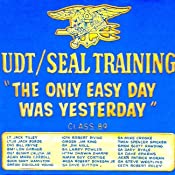Imagine being part of the most exclusive military force around – what does it take to get there? Picture this – you’re submerged in frigid water, lungs screaming for air. Your muscles are crying out from the relentless physical strain, and sleep deprivation is gnawing at your sanity. This isn’t some twisted version of an extreme sport – welcome to BUD/S or BUDS Navy SEAL Training.
This crucible molds ordinary men into extraordinary warriors capable of undertaking missions that would make even seasoned soldiers flinch.
But first, have you ever asked, ‘Where Is BUDS Training?’ If so, BUDS (or BUD/S) occurs on the Navy Amphibious Base in Coronado, California.
Are you intrigued yet? Dive with us as we deeply understand BUD/S training’s grueling three phases and infamous Hell Week. Learn how candidates steel themselves for these challenges and discover life after surviving BUD/S – Parachute Jump School, SEAL Qualification Training, and mission undertakings, all while carrying on a legacy since 1962.
Where is BUDS TrainingTable of Contents:
- The Rigors of BUD/S Navy SEAL Training
- Preparing for BUD/S Navy SEAL Training
- Post-BUD/S Navy SEAL Training
- The Role of Navy SEALs in the Military
- The Legacy and Impact of BUD/S Training
- FAQs with Bud/S Navy Seal Training
- Conclusion
The Rigors of BUD/S Navy SEAL Training
BUD/S Navy SEAL Training is an incredibly rigorous endeavor, not for the faint of heart. The Basic Underwater Demolition/SEAL (BUD/S) training is designed to push candidates to their physical and mental limits.
The Three Phases of BUD/S Training
Divided into three phases – Physical Conditioning, Diving, and Land Warfare- each stage uniquely molds elite warriors.
In the first phase of Physical Conditioning, trainees undergo an intense regimen to test endurance and strength. With over 75% dropout rate during this phase alone, it’s clear that not everyone is cut out for what comes next.
Hell Week in BUD/S Training
If surviving the initial weeks wasn’t challenging enough, welcome to “Hell Week.” A grueling five-day test marked by extreme sleep deprivation amidst rigorous military drills separates the strong from those who merely thought they were. This is part of underwater demolition training, where resilience plays as much a role as skill.
This level of intensity continues throughout all 24 weeks; it is no surprise then that the average age of trainees is just 22 years old. So, if you’re considering taking on such a challenge, remember: only the toughest survive.
Preparing for BUD/S Navy SEAL Training
If you want to become a Navy SEAL, Basic Underwater Demolition/SEAL (BUD/S) training is the first hurdle. Attempting to ascend Mount Everest while bearing the weight of an elephant is no easy feat, as BUD/S training requires.
Physical Fitness Requirements for BUD/S
The fitness benchmarks needed for this program are as challenging as they come. We suggest dedicating at least six months of intense preparation before stepping foot into the program.
This includes acing the physical screening test, which demands stellar performances in swimming and push-up tests, among other tasks. So imagine Michael Phelps’ swimming prowess combined with The Rock’s strength – that should give you a picture of what’s expected.
Moreover, preparing physically doesn’t just mean getting ripped – cardiovascular endurance plays a huge role, too. Long-distance running and high-intensity interval training can help build stamina, essential when facing grueling obstacle courses and underwater demolition exercises during BUD/S.
Above all else, though, remember this: mental toughness matters most because mind over matter isn’t just some fancy quote here—it’s survival instinct kicking in.
Post-BUD/S Navy SEAL Training
The journey to becoming a full-fledged Navy SEAL doesn’t end after surviving the grueling BUD/S program. It’s only just begun. After BUD/S training, more challenges need to be tackled.
First on the list is Parachute Jump School. This three-week course teaches candidates high altitude jumps and free fall techniques – skills crucial for covert insertions behind enemy lines.
Then comes an additional 28 weeks of SEAL Qualification Training (SQT). Here, they dive deeper into core tactical knowledge, including weapons training, combat diving, land navigation, and demolitions. The goal? To ensure these warriors can carry out any mission anywhere in the world at a moment’s notice.
Navy Facts confirms it takes nearly two years from start to finish before one earns their Trident pin and officially becomes a U.S. Navy SEAL.
Becoming a Navy Seal isn’t about checking boxes or finishing courses; it’s about transforming ordinary men into extraordinary warriors capable of undertaking some of our nation’s most sensitive operations.
Did You Know There Are Only 2,500 Active Navy SEALs
Though they number only around 2,500 active-duty Navy SEALs, they are essential to our nation’s defense. Military, their role is much more significant than their numbers suggest. The part these warriors play in protecting our country is immense.
Missions Undertaken by Navy SEALs
Navy SEAL teams take on some of the most challenging and critical missions globally. These include unconventional warfare assignments that require an exceptional set of skills.
These warriors often operate behind enemy lines to perform counterterrorism operations with surgical precision. But it’s not all about combat; they also perform hostage rescue missions where every second counts and lives hang in the balance.
Their extensive training lets them execute these complex tasks under extreme conditions, ensuring our national security remains unbreachable despite constant threats from various quarters.

BUD/S Training Like None Other
Operating since 1962, the Basic Underwater Demolition/SEAL (BUD/S) training program has left a lasting legacy on global military training. Its rigorous curriculum shaped generations of Navy SEALs, becoming a model for special forces worldwide.
One could compare the impact of BUD/S to that of an influential teacher. Just as such a figure can change students’ lives by pushing them beyond their perceived limits, so does this formidable program transform recruits into highly skilled warriors capable of land warfare, diving operations, and physical conditioning.
The legacy is not confined to those who make it through; even those who drop out carry lessons learned during their time at BUD/S. This immersive experience molds individuals into better versions of themselves – more robust, more resilient, and disciplined – traits beneficial in any walk of life.
BUD/S isn’t just about creating elite soldiers, building character, and fostering personal growth. Its influence extends well beyond the confines of Coronado’s sandy beaches or murky waters, where trainees spend countless hours striving for excellence under extreme conditions.
FAQs about BUDS Navy Seal Training
How long is SEAL training after BUDS?
Post-BUDS, trainees face another 28 weeks of rigorous schooling. This includes Parachute Jump School and SEAL Qualification Training.
What is Navy SEAL BUDS?
BUD/S stands for Basic Underwater Demolition/SEAL. It’s a grueling six-month program that all prospective Navy SEALS must conquer.
Is BUDS the most challenging part of SEAL training?
BUDS tests candidates to their limits, but many consider “Hell Week” the most challenging stretch.
Where is BUDS training for Navy Seals conducted?
The Naval Special Warfare Center in Coronado, California, hosts this test of physical endurance and mental fortitude known as BUDS.
